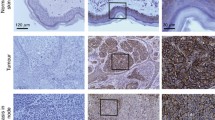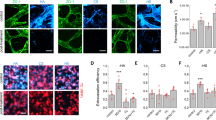Abstract
The glycocalyx consists of proteoglycans, glycoproteins, glycosaminoglycans, associated plasma proteins, and soluble glycosaminoglycans and covers the surface of all eukaryotic cells. It mediates specific recognition events, modulates biological processes such as ligand–receptor interactions, and has been proposed to affect tumor metastasis. Here, we studied whether the glycocalyx is required for melanoma cell migration. We diminished the glycocalyx of human melanoma cells by inhibiting posttranslational N-glycosylation or by enzymatic digestion of the N-glycosides. This partial destruction of the glycocalyx reduced melanoma cell migration by up to 60%. It was accompanied by the disintegration of a characteristic pH nanoenvironment typically surrounding migrating cells. Restoring this pH profile by stimulating the activity of the Na+/H+ exchanger NHE1 rescued cell migration even in the absence of an intact glycocalyx. The effects of partially removing the glycocalyx compared to those of knocking down β1-integrin expression points to a close functional correlation between glycocalyx, integrins, and cell surface pH nanoenvironment. We conclude that the glycocalyx is required for tumor cell migration. It stabilizes the cell surface pH nanoenvironment allowing a concerted pH-dependent interaction of adhesion receptors and extracellular matrix.










Similar content being viewed by others
References
Adair BD, Yeager M (2002) Three-dimensional model of the human platelet integrin alpha IIbbeta 3 based on electron cryomicroscopy and X-ray crystallography. Proc Natl Acad Sci U S A 99:14059–14064
Allen A, Flemstrom G (2005) Gastroduodenal mucus bicarbonate barrier: protection against acid and pepsin. Am J Physiol Cell Physiol 288:C1–19
Bironaite D, Nesland JM, Dalen H, Risberg B, Bryne M (2000) N-glycans influence the in vitro adhesive and invasive behaviour of three metastatic cell lines. Tumour Biol 21:165–175
Brummelkamp TR, Bernards R, Agami R (2002) A system for stable expression of short interfering RNAs in mammalian cells. Science 296:550–553
Cordes N, Seidler J, Durzok R, Geinitz H, Brakebusch C (2006) Beta1-integrin-mediated signaling essentially contributes to cell survival after radiation-induced genotoxic injury. Oncogene 25:1378–1390
Denker SP, Barber DL (2002) Cell migration requires both ion translocation and cytoskeletal anchoring by the Na–H exchanger NHE1. J Cell Biol 159:1087–1096
Dieterich P, Klages R, Preuss R, Schwab A (2008) Anomalous dynamics of cell migration. Proc Natl Acad Sci U S A 105:459–463
Dobrossy L, Pavelic ZP, Bernacki RJ (1981) A correlation between cell surface sialyltransferase, sialic acid, and glycosidase activities and the implantability of B16 murine melanoma. Cancer Res 41:2262–2266
Dricu A, Carlberg M, Wang M, Larsson O (1997) Inhibition of N-linked glycosylation using tunicamycin causes cell death in malignant cells: role of down-regulation of the insulin-like growth factor 1 receptor in induction of apoptosis. Cancer Res 57:543–548
Dzekunov SM, Spring KR (1998) Maintenance of acidic lateral intercellular spaces by endogenous fixed buffers in MDCK cell epithelium. J Membr Biol 166:9–14
Eble JA, Tuckwell DS (2003) The alpha2beta1 integrin inhibitor rhodocetin binds to the A-domain of the integrin alpha2 subunit proximal to the collagen-binding site. Biochem J 376:77–85
Elliott JT, Tona A, Plant AL (2003) Comparison of reagents for shape analysis of fixed cells by automated fluorescence microscopy. Cytometry A 52:90–100
Florian JA, Kosky JR, Ainslie K, Pang Z, Dull RO, Tarbell JM (2003) Heparan sulfate proteoglycan is a mechanosensor on endothelial cells. Circ Res 93:e136–e142
Ganz MB, Boyarsky G, Boron WF, Sterzel RB (1988) Effects of angiotensin II and vasopressin on intracellular pH of glomerular mesangial cells. Am J Physiol 254:F787–F794
Heifetz A, Keenan RW, Elbein AD (1979) Mechanism of action of tunicamycin on the UDP-GlcNAc:dolichyl-phosphate Glc-NAc-1-phosphate transferase. Biochemistry 18:2186–2192
Hynes RO (2002) Integrins: bidirectional, allosteric signaling machines. Cell 110:673–687
Ivaska J, Heino J (2000) Adhesion receptors and cell invasion: mechanisms of integrin-guided degradation of extracellular matrix. Cell Mol Life Sci 57:16–24
Klein M, Seeger P, Schuricht B, Alper SL, Schwab A (2000) Polarization of Na(+)/H(+) and Cl(−)/HCO (3)(−) exchangers in migrating renal epithelial cells. J Gen Physiol 115:599–608
Kovbasnjuk ON, Spring KR (2000) The apical membrane glycocalyx of MDCK cells. J Membr Biol 176:19–29
Lagana A, Vadnais J, Le PU, Nguyen TN, Laprade R, Nabi IR, Noel J (2000) Regulation of the formation of tumor cell pseudopodia by the Na(+)/H(+) exchanger NHE1. J Cell Sci 113(Pt 20):3649–3662
Lee GM, Johnstone B, Jacobson K, Caterson B (1993) The dynamic structure of the pericellular matrix on living cells. J Cell Biol 123:1899–1907
Lehenkari PP, Horton MA (1999) Single integrin molecule adhesion forces in intact cells measured by atomic force microscopy. Biochem Biophys Res Commun 259:645–650
Maaser K, Wolf K, Klein CE, Niggemann B, Zanker KS, Brocker EB, Friedl P (1999) Functional hierarchy of simultaneously expressed adhesion receptors: integrin alpha2beta1 but not CD44 mediates MV3 melanoma cell migration and matrix reorganization within three-dimensional hyaluronan-containing collagen matrices. Mol Biol Cell 10:3067–3079
Malo ME, Fliegel L (2006) Physiological role and regulation of the Na+/H+ exchanger. Can J Physiol Pharmacol 84:1081–1095
Nieuwdorp M, van Haeften TW, Gouverneur MC, Mooij HL, van Lieshout MH, Levi M, Meijers JC, Holleman F, Hoekstra JB, Vink H, Kastelein JJ, Stroes ES (2006) Loss of endothelial glycocalyx during acute hyperglycemia coincides with endothelial dysfunction and coagulation activation in vivo. Diabetes 55:480–486
Noble MI, Drake-Holland AJ, Vink H (2008) Hypothesis: arterial glycocalyx dysfunction is the first step in the atherothrombotic process. QJM 101:513–518
O'Hayre M, Salanga CL, Handel TM, Allen SJ (2008) Chemokines and cancer: migration, intracellular signalling and intercellular communication in the microenvironment. Biochem J 409:635–649
Patel H, Barber DL (2005) A developmentally regulated Na–H exchanger in Dictyostelium discoideum is necessary for cell polarity during chemotaxis. J Cell Biol 169:321–329
Pichierri F, Matsuo Y (2002) Effect of protonation of the N-acetyl neuraminic acid residue of sialyl Lewis(X): a molecular orbital study with insights into its binding properties toward the carbohydrate recognition domain of E-selectin. Bioorg Med Chem 10:2751–2757
Reitsma S, Slaaf DW, Vink H, van Zandvoort MA, oude Egbrink MG (2007) The endothelial glycocalyx: composition, functions, and visualization. Pflugers Arch 454:345–359
Rutkowski JM, Swartz MA (2007) A driving force for change: interstitial flow as a morphoregulator. Trends Cell Biol 17:44–50
Sardet C, Counillon L, Franchi A, Pouyssegur J (1990) Growth factors induce phosphorylation of the Na+/H+ antiporter, glycoprotein of 110 kD. Science 247:723–726
Stock C, Gassner B, Hauck CR, Arnold H, Mally S, Eble JA, Dieterich P, Schwab A (2005) Migration of human melanoma cells depends on extracellular pH and Na+/H+ exchange. J Physiol 567:225–238
Stock C, Mueller M, Kraehling H, Mally S, Noel J, Eder C, Schwab A (2007) pH nanoenvironment at the surface of single melanoma cells. Cell Physiol Biochem 20:679–686
Stuwe L, Muller M, Fabian A, Waning J, Mally S, Noel J, Schwab A, Stock C (2007) pH dependence of melanoma cell migration: protons extruded by NHE1 dominate protons of the bulk solution. J Physiol 585:351–360
Sundblad G, Kajiji S, Quaranta V, Freeze HH, Varki A (1988) Sulfated N-linked oligosaccharides in mammalian cells. III. Characterization of a pancreatic carcinoma cell surface glycoprotein with N- and O-sulfate esters on asparagine-linked glycans. J Biol Chem 263:8897–8903
Supino R, Prosperi E, Formelli F, Mariani M, Parmiani G (1986) Characterization of a doxorubicin-resistant murine melanoma line: studies on cross-resistance and its circumvention. Br J Cancer 54:33–42
Tarbell JM, Weinbaum S, Kamm RD (2005) Cellular fluid mechanics and mechanotransduction. Ann Biomed Eng 33:1719–1723
van den Berg B, Vink H (2006) Glycocalyx perturbation: cause or consequence of damage to the vasculature? Am J Physiol Heart Circ Physiol 290:H2174–2175
van Muijen GN, Jansen KF, Cornelissen IM, Smeets DF, Beck JL, Ruiter DJ (1991) Establishment and characterization of a human melanoma cell line (MV3) which is highly metastatic in nude mice. Int J Cancer 48:85–91
Vink H, Constantinescu AA, Spaan JA (2000) Oxidized lipoproteins degrade the endothelial surface layer: implications for platelet–endothelial cell adhesion. Circulation 101:1500–1502
Weinbaum S, Tarbell JM, Damiano ER (2007) The structure and function of the endothelial glycocalyx layer. Annu Rev Biomed Eng 9:121–167
Yamaguchi H, Wyckoff J, Condeelis J (2005) Cell migration in tumors. Curr Opin Cell Biol 17:559–564
Zhao YY, Takahashi M, Gu JG, Miyoshi E, Matsumoto A, Kitazume S, Taniguchi N (2008) Functional roles of N-glycans in cell signaling and cell adhesion in cancer. Cancer Sci 99:1304–1310
Acknowledgments
This study was supported by the Deutsche Forschungsgemeinschaft (DFG; grant numbers Schw 407/10-1 and Eb 177/5-1), by the fund “Innovative Medical Research” of the University of Münster Medical School (grant number: ST 210601), and by the Rolf Dierichs-Stiftung (grant to C.S. (BD 193439)). Cariporide was a kind gift from Drs. H-J. Lang and J. Pünter at Sanofi Aventis. We extend special thanks to Drs. A. Fabian, K. Kusche-Vihrog, and Y. Treffner for technical expertise with the siRNA technique.
Author information
Authors and Affiliations
Corresponding author
Rights and permissions
About this article
Cite this article
Krähling, H., Mally, S., Eble, J.A. et al. The glycocalyx maintains a cell surface pH nanoenvironment crucial for integrin-mediated migration of human melanoma cells. Pflugers Arch - Eur J Physiol 458, 1069–1083 (2009). https://doi.org/10.1007/s00424-009-0694-7
Received:
Accepted:
Published:
Issue Date:
DOI: https://doi.org/10.1007/s00424-009-0694-7




